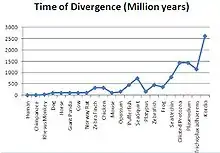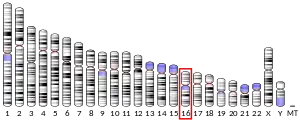| KIAA0895L | |||||||||||||||||||||||||||||||||||||||||||||||||||
|---|---|---|---|---|---|---|---|---|---|---|---|---|---|---|---|---|---|---|---|---|---|---|---|---|---|---|---|---|---|---|---|---|---|---|---|---|---|---|---|---|---|---|---|---|---|---|---|---|---|---|---|
| Identifiers | |||||||||||||||||||||||||||||||||||||||||||||||||||
| Aliases | KIAA0895L, KIAA0895 like | ||||||||||||||||||||||||||||||||||||||||||||||||||
| External IDs | MGI: 1921606 HomoloGene: 47588 GeneCards: KIAA0895L | ||||||||||||||||||||||||||||||||||||||||||||||||||
| |||||||||||||||||||||||||||||||||||||||||||||||||||
| |||||||||||||||||||||||||||||||||||||||||||||||||||
| |||||||||||||||||||||||||||||||||||||||||||||||||||
| |||||||||||||||||||||||||||||||||||||||||||||||||||
| Wikidata | |||||||||||||||||||||||||||||||||||||||||||||||||||
| |||||||||||||||||||||||||||||||||||||||||||||||||||
Uncharacterized protein KIAA0895-like also known as LOC653319, is a protein that in humans is encoded by the KIAA0895L gene.[5]
Gene
KIAA0895L is located at q22.1 on chromosome 16 of the human genome.[6] Its genomic DNA consists of 8,379 base pairs.[7] KIAA0895L is located between EXOC3L and E2F4 on the right, and NOL3 and HSF4 on the left.[8] The promoter for KIAA0895L is located on chromosome 16 and spans 67217367-67218383bp.[9][10]
KIAA0895L was first documented by the Mammalian Gene Collection Program Team in 2002.[11] There are several patents on KIAA0895L, two of those being patent US 6943241 and patent EP1308459.[12]
Species distribution

KIAA0895L orthologs can be found in all mammals.[13] It is not found in plants, archaea, or fungi. KIAA0895L has a single paralog, known as KIAA0895.[14]
The known orthologs of KIAA0895L are listed below:[15][16]
- Chimpanzee – LOC741288
- Rhesus monkey – LOC696623
- Dog – LOC489765
- Horse – LOC100053028
- Giant panda – PANDA_006923
- Cow – LOC512420
- Norway rat – LOC688736
- Zebra finch – LOC100223241
- Chicken – LOC415660
- Mouse – LOC74356
- Opossum – LOC100019983
- Puffer fish – Unnamed
- Sea squirt – LOC100177006
- Platypus – LOC100078127
- Zebrafish – LOC562097
- Frog – LOC100135412
- Sea urchin – KIAA0895
- Ciliated protozoa – TTherm_01042050
- Plasmodium – PY05482
- Trichoplax adherens – TRIADDRAFT_62861
- Kordia – KAOT1_03617
Structure
| Domain of unknown function 1704 | |||||||||
|---|---|---|---|---|---|---|---|---|---|
| Identifiers | |||||||||
| Symbol | DUF1704 | ||||||||
| Pfam | PF08014 | ||||||||
| InterPro | IPR012548 | ||||||||
| |||||||||
KIAA0895L is composed of 471 amino acids (53.5kDa).[17] A proline-rich region was also revealed at 14-65 amino acids.[18] There is also an area of low complexity at 2913-2917 bp in the 3’ UTR region.[19][20] There is a conserved domain of unknown function, known as DUF1704, located at 1390-2083 bp.[21]

Predicted post translational modifications
The following is a list of predicted post translational modifications found for KIAA0895L.[22] These are predicted in all mammalian orthologs in the public sequence database.
| type of modification | residues modified |
|---|---|
| O-GlaNAc glycosylation | T19, T96, T174, and T314 |
| Ser, Thr, and Tyr phosphorylation | S16, S20, S23, S31, S80, S82, S85, S88, S136, S349, S419, T96, T112, T125, T284, T379, T406, Y84, Y360, and Y420 |
| Kinase-specific phosphorylation | T96 and T125 |
Interacting proteins
No proteins that interact with KIAA0895L or its homolog have yet been identified.
Tissue distribution
KIAA0895L is expressed in many tissues of the body such as brain, testis, mammary glands, bladder, and the eye.[23]
Clinical significance
KIAA0895L has been shown to be up regulated[24] in lymphoblastoid cells from males with autism that is caused by an expansion of a CGG repeat in the promoter region of the fragile X mental retardation 1 gene located at Xq27.3[25] as well as in cells with a 15q11-q13 mutation.
Notes and references
- 1 2 3 GRCh38: Ensembl release 89: ENSG00000196123 - Ensembl, May 2017
- 1 2 3 GRCm38: Ensembl release 89: ENSMUSG00000014837 - Ensembl, May 2017
- ↑ "Human PubMed Reference:". National Center for Biotechnology Information, U.S. National Library of Medicine.
- ↑ "Mouse PubMed Reference:". National Center for Biotechnology Information, U.S. National Library of Medicine.
- ↑ "Entrez Gene: KIAA0895-like".
- ↑ Genecards bin/cards/carddisp.pl?gene=KIAA0895L&search=KIAA0895L
- ↑ NCBI
- ↑ NCBI Entrez Gene
- ↑ UCSC Genome Bioinformatics
- ↑ Genomatix
- ↑ Strausberg RL, Feingold EA, Grouse LH, et al. (December 2002). "Generation and initial analysis of more than 15,000 full-length human and mouse cDNA sequences". Proc. Natl. Acad. Sci. U.S.A. 99 (26): 16899–903. Bibcode:2002PNAS...9916899M. doi:10.1073/pnas.242603899. PMC 139241. PMID 12477932.
- ↑ BLAST (Basic Local Alignment Search Tool)
- ↑ KEGG
- ↑ KEGG
- ↑ SDBC(San Diego Supercomputer Center Biology Workbench)
- ↑ Higgins DG, Bleasby AJ, Fuchs R (April 1992). "CLUSTAL V: improved software for multiple sequence alignment". Comput. Appl. Biosci. 8 (2): 189–91. doi:10.1093/bioinformatics/8.2.189. PMID 1591615.
- ↑ Genecards bin/cards/carddisp.pl?gene=KIAA0895L&search=KIAA0895L
- ↑ KEGG(Kyoto Encyclopedia of Genes and Genomes)
- ↑ Dotlet(My Hits)
- ↑ Junier T, Pagni M (February 2000). "Dotlet: diagonal plots in a web browser". Bioinformatics. 16 (2): 178–9. doi:10.1093/bioinformatics/16.2.178. PMID 10842741.
- ↑ BLAST(Basic Local Alignment Search Tool)
- ↑ Swiss Institute of Bioinformatics, ExPASy
- ↑ Genecards
- ↑ NCBI GEO (National Center for Biotechnology Information Gene Expression Omnibus)
- ↑ Nishimura Y, Martin CL, Vazquez-Lopez A, Spence SJ, Alvarez-Retuerto AI, Sigman M, Steindler C, Pellegrini S, Schanen NC, Warren ST, Geschwind DH (July 2007). "Genome-wide expression profiling of lymphoblastoid cell lines distinguishes different forms of autism and reveals shared pathways". Hum. Mol. Genet. 16 (14): 1682–98. doi:10.1093/hmg/ddm116. PMID 17519220.



